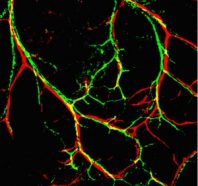Scientists help amputees by getting on their nerves
Nerves run throughout the human body like an electrified spider web. They’re everywhere — in your skin, your muscles and your organs. Signals zip along the nerves, taking information to and from the brain. The brain, like a spider, always knows where and when something is happening.
Or at least, it thinks it knows. Since the brain relies so heavily on nerves, nerves can be used to trick the brain. The right kind of trickery might be able to help people. That’s the case in a recent experiment done at the Rehabilitation Institute of Chicago in which researchers studied two amputees and their prostheses. An amputee is someone who has lost a limb, and a prosthesis, or prosthetic limb, is an artificial version of that limb that can assist the amputee.

A prosthetic limb can be hard to get used to, and part of the problem has to do with our senses. Seeing and feeling are particularly important to how we move our bodies. If you’re hammering something, you can see that your fingers are out of the way. Or if you touch something hot, you pull back your hand, even though you don’t see the actual heat. Amputees usually have to rely on vision alone. They can see what they’re doing with their limbs, but they can’t feel what’s going on.
The new experiment looks at a way to help people “feel” what their prosthetic limbs are doing. It may give amputees a more natural way to think about their new limbs, incorporating them as part of their bodies.
The two participants in the experiment had gone through a surgical procedure called targeted reinnervation. As you might guess by seeing part of the word nerve in reinnervation, the surgery changed the patients’ nerves. The surgeons first found the ends of the nerves that used to go down the amputees’ arms. Then, they attached those nerve endings to a patch of skin above where the amputation was done.
To the brain, a feeling of touch on this patch of skin was like a feeling of touch on the arm that used to be there. If you were to touch that part of the skin, the amputee would feel it as if you touched his missing arm — because that’s where the nerve used to go.
For the experiment, each amputee sat at a table with a prosthetic arm that was nearby but not attached. These prosthetic arms were special: When they detected touch, they sent a message to a small robot, which would then touch the special patch of skin on the amputee’s arm.
So, when a researcher touched the artificial arm, the robot touched the amputee, and the amputee felt it where the missing arm used to be. Through this process, a person could feel a touch on a prosthetic arm as though feeling the touch on her own arm.
In other words, what they saw — a touch — is also what they felt. Seeing and feeling happened at the same time. During this part of the experiment, the amputees told the researchers they felt like the fake arm was a natural part of their bodies. At times in the experiment when the amputees saw the prosthetic arm being touched but weren’t made to feel anything, they said the fake arm did not seem like part of their bodies.
“It was really when the touch matched what they saw, that we saw these changes,” Paul Marasco told Science News. Marasco led the experiment and designed the robotic touch-sensing system on the prosthetic arms. He now conducts research at the Advanced Platform Technology Center at the Veterans Affairs Medical Center in Cleveland.
By feeling what they’re seeing, and seeing what they’re feeling, amputees might be able to adopt their new limbs more easily. Then the prosthesis might really seem and feel like another body part, not just an attached tool, the researchers say.
Michael Goldfarb, who was not involved in the study, told Science News the new study is a “baby step,” but an important one. Goldfarb is a bioengineer at Vanderbilt University in Nashville, Tenn. A bioengineer applies knowledge from engineering to help solve problems related to biology and the human body. “What makes you feel something is a part of you is not just being able to move it,” he said.
POWER WORDS (adapted from the Yahoo! Kids Dictionary)
bioengineers Scientists who use ideas from engineering to learn more about biology and medicine. They might design aids or replacements for defective or missing body parts or organs.
amputee A person who has had one or more limbs removed.
prosthesis An artificial body part, such as a limb.
nerve A bundle of fibers that carry messages between the brain or other parts of the central nervous system and the eyes, glands, muscles, and other parts of the body. Nerves form a network of pathways for conducting information throughout the body.
network Wires, nerves, threads, roads, etc. formed into a structure have intersecting lines and resembling a net.







